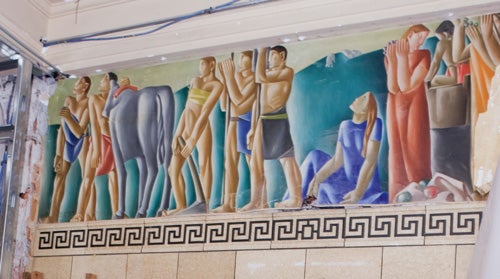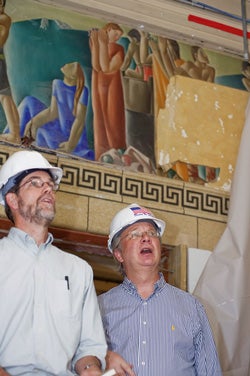Historic Murals Discovered in Edwards Hall

Seventy-one years ago during the Great Depression, Providence artist Gino Conti completed his final set of mural paintings for the lobby of Edwards Hall at Rhode Island State College.
But until mid-July of 2010, no one knew that Conti’s murals had survived renovations that kept them hidden for 43 years.

As a $1.5 million summer renovation progressed, workers with Calson Corp discovered the murals in the Edwards lobby. They sought the expertise of the library staff and the Art Department, which then called the University’s Business Services and Capital Projects offices.
On August 9, a two-person team from the Williamstown Art Conservation Center in Williamstown, Mass., began removing the murals for conservation.
Thomas Branchick, director and conservator of paintings at Williamstown, was encouraged to find that the oil-on-canvas paintings were attached to the walls with wallpaper paste, which simplified their removal from the wall: “The nice thing about that kind of adhesive is that it desiccates with time, meaning it is very brittle.”
He added that the paintings are dusty because of the construction, but they will be cleaned, which will substantially improve their clarity. Branchick recommends that the restored paintings be mounted on panels so that they can be easily moved in the future.
For Professor Ron Onorato, an art historian who wrote a paper in the early 1980s on “Rhode Island’s WPA Art,” the discovery is great news. His paper addresses the sad history of many works of art from the Depression era: “Many, like the projects for Edwards Hall, have been painted out, destroyed, or otherwise lost.”
Like thousands of other artists who struggled to find work during the Great Depression, Conti, who was born in Italy and studied at the Rhode Island School of Design, benefited from the New Deal program of the Works Projects Administration. Today in 2010, the American Recovery and Reinvestment Act, designed to lessen the suffering of what many have called the worst economic crisis since the Depression, is responsible for the discovery of Conti’s murals.
Even though sections of the paintings have been damaged by framework that was nailed to the murals and some pieces are torn at the corners, the images remain remarkably colorful and powerful.
According to the March 16, 1941 Providence Journal, “Of the two largest panels, one symbolizes drama, music, and dance; the other the protection of youth; striving for progress; and the past. Four smaller canvasses depict the elements with groups of figures symbolizing water, fire, air, and workers in the soil.”
In January 1940, Samuel M. Green, the supervisor of the Rhode Island Art Project, wrote to Rhode Island State College President Raymond G. Bressler about murals for Green Hall and Edwards Hall. The Green Hall murals, done by a different artist, have never been recovered.
By Dave Lavallee ’79, M.P.A. ’87
 Home
Home Browse
Browse Close
Close Events
Events Maps
Maps Email
Email Brightspace
Brightspace eCampus
eCampus


